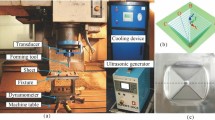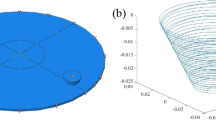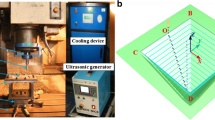Abstract
The incremental sheet forming (ISF) is an innovative dieless forming process featured with high formability and short lead time which is suitable for rapid prototyping and small volume production. The integration of ultrasonic (US) vibration into the ISF process can significantly reduce the forming force and bring other benefits. In this work, the impacts of process parameters including the sheet material, US power, feeding speed, and tool diameter, on force reduction and temperature increment were studied. The force reduction contains two components—the stress superposition-induced force reduction and acoustic softening-induced force reduction. The stress superposition-induced force reduction was analyzed by finite element simulation while the total force reduction was detected by experiments since currently, the unknown mechanism of the acoustic softening cannot be modeled. The temperature increment was measured by a high-speed infrared camera. The results show that the force reduction can go up to 56.58% and the temperature increment can be as high as 24.55 °C. In general, the material with a higher yield stress results in a higher force reduction and a higher temperature increment. A higher US power or a lower feeding speed can significantly enhance the force reduction and the interface temperature increment. The tool with a smaller diameter has a comparable effect as a larger tool, but a larger vibration amplitude is required.
Similar content being viewed by others
References
Leszak E (1967) Apparatus and process for incremental dieless forming. USA Patent 3342051A
Kitazawa K, Wakabayashi A, Murata K, Yaejima K (1996) Metal-flow phenomena in computerized numerically controlled incremental stretch-expanding of aluminum sheets, vol 46. vol 2. Keikinzoku Tokyo
Jeswiet J (2001) Incremental single point forming. Trans North Am Manuf Res Inst SME 29:75–79
Amino M, Mizoguchi M, Terauchi Y, Maki T (2014) Current status of “Dieless” Amino's incremental forming. Procedia Engineering 81(0):54–62
Ambrogio G, Cozza V, Filice L, Micari F (2007) An analytical model for improving precision in single point incremental forming. J Mater Process Technol 191(1–3):92–95
Allwood JM, Braun D, Music O (2010) The effect of partially cut-out blanks on geometric accuracy in incremental sheet forming. J Mater Process Technol 210(11):1501–1510
Lu H, Kearney M, Li Y, Liu S, Daniel WJT, Meehan PA (2016) Model predictive control of incremental sheet forming for geometric accuracy improvement. Int J Adv Manuf Technol 82(9–12):1781–1794
Durante M, Formisano A, Langella A (2010) Comparison between analytical and experimental roughness values of components created by incremental forming. J Mater Process Technol 210(14):1934–1941
Hamilton K, Jeswiet J (2010) Single point incremental forming at high feed rates and rotational speeds: surface and structural consequences. CIRP Ann Manuf Technol 59(1):311–314
Mohammadi A, Vanhove H, Van Bael A, Duflou JR (2016) Towards accuracy improvement in single point incremental forming of shallow parts formed under laser assisted conditions. Int J Mater Form 9(3):339–351
Malhotra R, Cao J, Beltran M, Xu D, Magargee J, Kiridena V, Xia ZC (2012) Accumulative-DSIF strategy for enhancing process capabilities in incremental forming. CIRP Ann Manuf Technol 61(1):251–254
Liu R, Lu B, Xu D, Chen J, Chen F, Ou H, Long H (2016) Development of novel tools for electricity-assisted incremental sheet forming of titanium alloy. Int J Adv Manuf Technol 85(5):1137–1144
Cui XH, Mo JH, Li JJ, Zhao J, Zhu Y, Huang L, Li ZW, Zhong K (2014) Electromagnetic incremental forming (EMIF): a novel aluminum alloy sheet and tube forming technology. J Mater Process Technol 214(2):409–427
Rasoli MA, Abdullah A, Farzin M, Tehrani AF, Taherizadeh A (2012) Influence of ultrasonic vibrations on tube spinning process. J Mater Process Technol 212(6):1443–1452
Blaha F, Langenecker B (1955) Dehnung von Zink-Kristallen unter Ultraschalleinwirkung. Naturwissenschaften 45(20):556–556 (in German)
Nevill GE, Brotzen FR (1957) The effect of vibrations on the static yield strength of a low-carbon steel. Proc Am Soc Test Mater 57:751–758
Blaha F, Langenecker B (1959) Ultrasonic investigation of the plasticity of metal crystals. Acta Metall 7(2):93–100
Daud Y, Lucas M, Huang Z (2007) Modelling the effects of superimposed ultrasonic vibrations on tension and compression tests of aluminium. J Mater Process Technol 186(1–3):179–190
Daud Y, Lucas M, Huang Z (2006) Superimposed ultrasonic oscillations in compression tests of aluminium. Ultrasonics 44(SUPPL):e511–e515
Aziz SA, Lucas M (2012) Characterising the acoustoplastic effect in an ultrasonically assisted metal forming process. IOP Conf Ser Mater Sci Eng 42:012017. https://doi.org/10.1088/1757-899X/42/1/012017
Yao Z, Kim GY, Faidley L, Zou Q, Mei D, Chen Z (2012) Effects of superimposed high-frequency vibration on deformation of aluminum in micro/meso-scale upsetting. J Mater Process Technol 212(3):640–646
Storck H, Littmann W, Wallaschek J, Mracek M (2002) The effect of friction reduction in presence of ultrasonic vibrations and its relevance to travelling wave ultrasonic motors. Ultrasonics 40(1–8):379–383
Vahdati M, Mahdavinejad R, Amini S (2015) Investigation of the ultrasonic vibration effect in incremental sheet metal forming process. Proceedings of the Institution of mechanical engineers, Part B J Eng Manuf
Amini S, Hosseinpour Gollo A, Paktinat H (2016) An investigation of conventional and ultrasonic-assisted incremental forming of annealed AA1050 sheet. Int J Adv Manuf Technol:1–10
Qi H, Wen DH, Lu CD, Li G (2016) Numerical and experimental study on ultrasonic vibration-assisted micro-channelling of glasses using an abrasive slurry jet. Int J Mech Sci 110:94–107
Acknowledgements
The authors would like to thank the preparatory visit funding from Sino-German Center for Research Promotion (GZ1381). Dr. Yanle Li is also funded by National Natural Science Foundation of China (51605258), China Postdoctoral Science Foundation funded project (2016M592180), and Postdoctoral innovation project of Shandong Province (201701011).
Author information
Authors and Affiliations
Corresponding author
Rights and permissions
About this article
Cite this article
Long, Y., Li, Y., Sun, J. et al. Effects of process parameters on force reduction and temperature variation during ultrasonic assisted incremental sheet forming process. Int J Adv Manuf Technol 97, 13–24 (2018). https://doi.org/10.1007/s00170-018-1886-0
Received:
Accepted:
Published:
Issue Date:
DOI: https://doi.org/10.1007/s00170-018-1886-0




